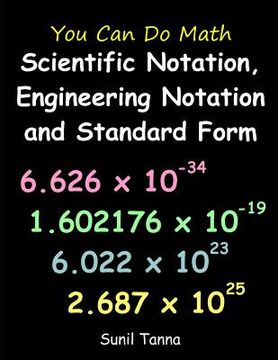Compartir
You Can Do Math: Scientific Notation, Engineering Notation and Standard Form (en Inglés)
Sunil Tanna
(Autor)
·
Independently Published
· Tapa Blanda
You Can Do Math: Scientific Notation, Engineering Notation and Standard Form (en Inglés) - Tanna, Sunil
S/ 85,92
S/ 171,84
Ahorras: S/ 85,92
Elige la lista en la que quieres agregar tu producto o crea una nueva lista
✓ Producto agregado correctamente a la lista de deseos.
Ir a Mis Listas
Origen: Estados Unidos
(Costos de importación incluídos en el precio)
Se enviará desde nuestra bodega entre el
Lunes 01 de Julio y el
Lunes 15 de Julio.
Lo recibirás en cualquier lugar de Perú entre 2 y 5 días hábiles luego del envío.
Reseña del libro "You Can Do Math: Scientific Notation, Engineering Notation and Standard Form (en Inglés)"
This book provides a complete guide to scientific notation (known in the UK as standard form) and engineering notation. It explains how the notation works, the advantages of using it, how to convert to and from it, how to compare numbers and orders of magnitude, and even how to perform approximate arithmetic operations (without using a calculator) such as addition, subtraction, multiplication, division, exponentiation, square roots, cube roots, and logarithms on numbers in scientific notation. There are over 200 questions and answers (answers explain how to get the answer) to help you master this important math topic. Table of contents is: Chapter 1: What are Scientific Notation and Engineering Notation?Whole Number Powers of 10What is Scientific Notation?- Converting Decimal Numbers to Normalized Scientific Notation- Converting Scientific Notation to DecimalWhat is Normalized Scientific Notation (Standard Form)?- Significant Figures- Estimated Final Digits- E-notation and Other Notational Standards- Converting Decimal Numbers to Normalized Scientific Notation- Converting Scientific Notation to DecimalWhat is Engineering Notation?- Significant Figures- Engineering Notation and SI Unit Prefixes- Converting Decimal Numbers to Engineering Notation- Converting Engineering Notation to DecimalNormalizing and Denormalizing Numbers in Scientific and Engineering Notation- Increasing the Value of the Exponent and Decreasing the Absolute Value of the Coefficient- Decreasing the Value of the Exponent and Increasing the Absolute Value of the Coefficient- Converting a Number in Normalized Scientific Notation to Engineering Notation- Converting a Number in Engineering Notation to Normalized Scientific NotationQuestions Answers to Chapter 1 Questions Chapter 2: Comparing Numbers in Scientific NotationComparing Numbers in Normalized Scientific NotationComparing Numbers in Engineering NotationComparing Numbers in Denormalized Scientific NotationQuestions Answers to Chapter 2 Questions Chapter 3: Orders of MagnitudeDefinitions of Order of MagnitudeOrder of Magnitude EstimatesOrder of Magnitude Differences- Approximate Order of Magnitude Differences Questions Answers to Chapter 3 Questions Chapter 4: Adding & SubtractionHow to Add Numbers in Scientific and Engineering Notation- Approximate Addition in Scientific and Engineering NotationHow to Subtract Numbers in Scientific and Engineering Notation- Approximate Subtraction in Scientific and Engineering NotationQuestions Answers to Chapter 4 Questions Chapter 5: Multiplication and DivisionHow to Multiply Numbers in Scientific and Engineering Notation- Approximate Multiplication in Scientific and Engineering NotationHow to Divide Numbers in Scientific and Engineering Notation- Approximate Division in Scientific and Engineering NotationQuestions Answers to Chapter 5 Questions Chapter 6: ExponentiationHow to Exponentiate Numbers in Scientific and Engineering Notation- Approximate Exponentation in Scientific and Engineering NotationHow to Find Approximate Square Roots in Scientific and Engineering NotationHow to Find Approximate Cube Roots in Scientific and Engineering NotationQuestions Answers to Chapter 6 Questions Chapter 7: LogarithmsHow to Calculate Approximate Logarithms in Base 10How to Calculate Approximate Logarithms in Base 2How to Calculate Approximate Natural LogarithmsQuestions Answers to Chapter 7 Questions Conclusion
- 0% (0)
- 0% (0)
- 0% (0)
- 0% (0)
- 0% (0)
Todos los libros de nuestro catálogo son Originales.
El libro está escrito en Inglés.
La encuadernación de esta edición es Tapa Blanda.
✓ Producto agregado correctamente al carro, Ir a Pagar.

